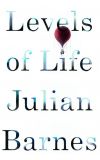
10 Apr 2013 00:43:28
Shah Jahan built the minareted tomb for his third wife when she died after delivering their 14th child; Barnes, who is uxorious – as he points out – in the strict sense of the word, is writing here to commemorate his one irreplaceable wife, Pat Kavanagh, who was in a sense the "onlie begetter" of his 20 books and who remains the dedicatee of whatever he writes, even though she died in 2008. Barnes once adopted her surname as a pseudonym. Now in Levels of Life she is honoured as a co-creator, with her own photograph – quizzical, challenging, gloriously beautiful – on the back flap beneath his.
But the Taj is a mausoleum: like the book, it couldn't keep alive the precious human being it praises. Religion duped us by pretending to vanquish death: are we fools for expecting art to do the same?
Levels of Life concludes with a raw, aching elegy. Before reaching that dead end, however, it goes for a characteristic wander around the universe, almost in the manner of Barnes's zigzagging tour through the centuries in A History of the World in 10½ Chapters. Here the itinerary is spatial, not temporal. The levels of life are the three tiers of our existence, storeys between which we commute and stories that we tell as we do so. Barnes starts in the stratosphere, with a semi-documentary account of the dotty balloonists who launched themselves into the sky in the late 19th century. He then settles down to ground in a fictionalised account of an affair between one of these aeronauts, a doughty colonel in the Horse Guards, and the actress Sarah Bernhardt. Then comes the inevitable descent underground to catacombs and corpses, with Barnes's account of his abrupt and unbearable bereavement.
The combination of forms and styles, slipping to and fro between airy fantasy and the grim immitigable facts of disease and death, really shouldn't work – but it does, thanks to Barnes's deft emotional insight and his verbal legerdemain. The progress from sky to earth to six feet under is doomy, dragged by gravity like the balloonists when their contraptions plunge back to earth. But this depression is countered by Barnes's skill and guile in recycling ideas and phrases, motifs that bounce about and recur in startling new contexts until by the end they hold together a book that is at once airy and dense, frivolous and morose. Levity makes up for gravity, and – like Barnes's characters when they puzzle over flying machines with their paradoxical fusion of lightness and force – you are left wondering how the magical feat has been accomplished.
In retrospect it all becomes clearer. Everything in the first two sections, no matter how wayward, prepares for the third part, which seems so different in its pain and anger. Barnes's "balloonatics" are committing "the sin of aspiration", which destroyed Icarus; like the pilot in his early novel Staring at the Sun, they have invaded the realm that God recently vacated. Their exploits suggest that our soaring, floating happiness – like that which Barnes enjoyed in 30 years of marriage – will have to be paid for in grief when the buoyant cloud deflates. "The universe is exact," a friend whose husband has died tells Barnes: our misery when we lose a partner is commensurate with our love for them (though mercifully it won't, if we're lucky, last as long).
The second section, in which Colonel Fred Burnaby romances the capricious Bernhardt, initially puzzled me, and I wondered if it was just another exercise in historical reanimation, like Arthur & George. In fact it's a peekaboo admission that fiction is fact adroitly displaced and rearranged, since Barnes here indirectly recreates his relationship with his wife.
Pat is absent from the third section of the book – already lost to the world, not even described for the benefit of readers. (I speak of her personally because she was my agent and my friend for 32 years; I claim no priority, but can hear the bell dolefully tolling as I recall that I met her two years before Barnes did.) I understand his reticence. To treat her as a character would have meant squandering their intimacy; he calls himself "her principal rememberer", but the memory remains "internalised", secreted within. Putting her into the book would also have pretended she could be somehow brought back to life, which Barnes, stoically atheistic, knows to be weak-minded folly.
Instead he casts her as Bernhardt the alluring actress, with himself, I suspect, as her worshipful, ultimately unworthy admirer, only too aware – like the heroes of Flaubert's Parrot and Before She Met Me – of "her smiling retinue of former lovers". Fiction is the amelioration of fact: when Bernhardt drops Burnaby, his pain is eased by travelling and by imperial wars, in one of which he has the good fortune to be speared in the neck and killed.
The third section of Levels of Life is literally self-mortifying, as Barnes imagines a scenario for suicide and selects the sharp Japanese knife that might bring about his quietus. Those who grieve can't forgive other human beings for having the cheek to be still alive; Barnes shows little mercy to friends who try clumsily to console or divert him, and he brings to bear a lexicographer's contempt when they use inappropriate words to euphemise the stark truth of death. I have the feeling that he didn't expect or even wish to recover from this anguish, itself a fatal illness. Luckily the mood lightens on the final pages of the book, as he writes himself back to equilibrium, if not acceptance, and recovers his delight in "the miraculous trickery of art".
Those words, like all those he uses, are carefully chosen. Art performs tricks not miracles, and resurrection is beyond its powers. But representation – revisiting the past to make it present again – may be the next best thing and our only hope.

